Next week, 29 states will hold elections for positions on their highest courts. These courts exercise tremendous power over American life and issue crucial decisions on matters ranging from public education funding to reproductive rights. But state high courts badly fail to reflect the diversity of the communities they serve — and it’s unlikely this will change this year.
According to a Brennan Center analysis, during this election cycle, only 11.9 percent of candidates running in state supreme court elections are people of color, and only 36.5 percent of candidates are female. Just 4.8 percent are women of color.
The problem goes beyond this year’s crop of candidates. In 2016, people of color were nearly 39 percent of the U.S. population but just 13 percent of state supreme court justices, according to Brennan Center data. And 24 state supreme courts did not have a single person of color on the bench. Similarly, 11 state high courts had only one or no female justices, and only 36 percent of all state supreme court justices were female.
Diversity is crucial for an effective judiciary. It fosters better jurisprudence by bringing a broader set of perspectives into the judicial decision-making process. A diverse bench also promotes public confidence in the objectivity and fairness of the judicial system.
State supreme court diversity has lagged behind overall diversity in the United States for a host of reasons, ranging from inadequate law school pipelines to fundraising hurdles. But our research also suggests another critical factor: state supreme court elections do not draw a diverse set of candidates, and white candidates have higher success rates in these elections than people of color. In all, 22 states use contested state supreme court elections to fill seats on the bench. Future analyses will examine these dynamics in appointive systems.
State supreme court elections do not draw a diverse set of candidates
Few people of color run for state supreme courts — and these figures have remained stagnant over time. Over the past 18 years, the percentage of candidates of color has stagnated while the diversity of the U.S. population has increased substantially. Notably, the percentage of candidates who are people of color this cycle is the same as it was in the 2001–02 cycle. And there was no election cycle in which more than 12.9 percent of candidates were people of color. In contrast, people of color made up 30.9 percent of the general population in 2000, and that percentage has increased ever since.
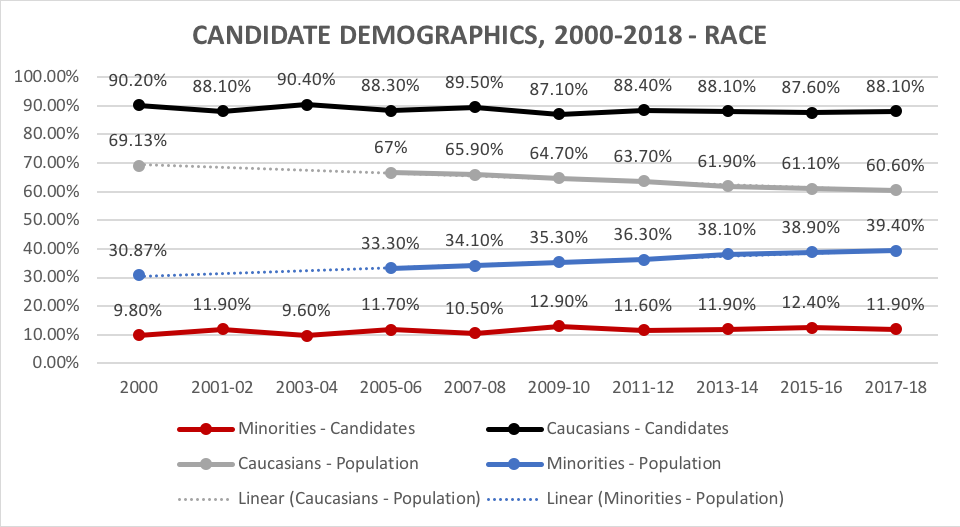
Estimates from the United States Census Bureau, American FactFinder – Annual Estimates of the Resident Population by Sex, Age, Race Alone or in Combination, and Hispanic Origin for the United States and States; ACS Demographic and Housing Estimates, 2014 American Community Survey 1-Year Estimates. Estimates for the years 2001–2004 were not available: the dotted lines merely connect the 2000 and the 2005–6 data points, but do not contain data for 2001–2004.
The percentage of female state supreme court candidates has grown modestly but notably in the past 18 years. This cycle, 36.5 percent of candidates are female — the highest percentage of any cycle since our data began in 2000. But that still falls far short of the share of women in the overall population.
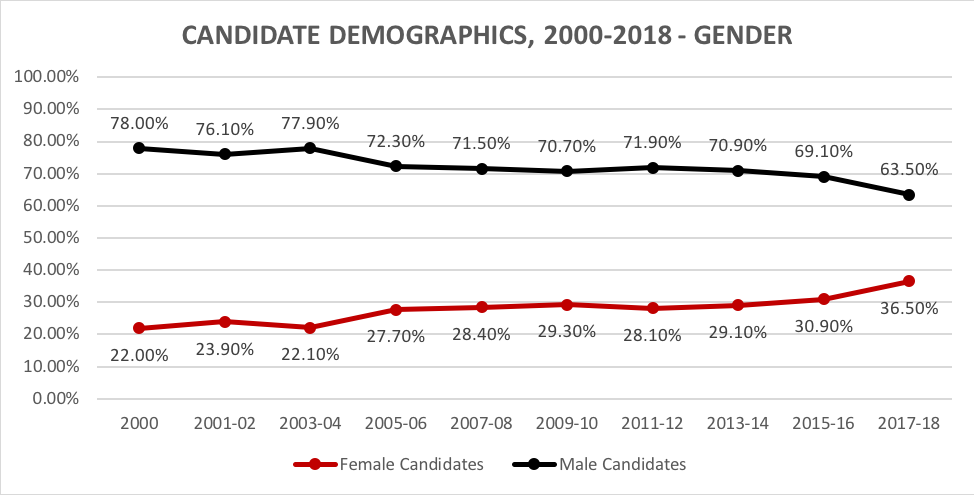
When people of color run for state supreme courts, they win less often than white candidates do
When non-incumbent minority candidates run for state supreme court — either as challengers to incumbents or as candidates for open seats — they have lower success rates than white candidates.
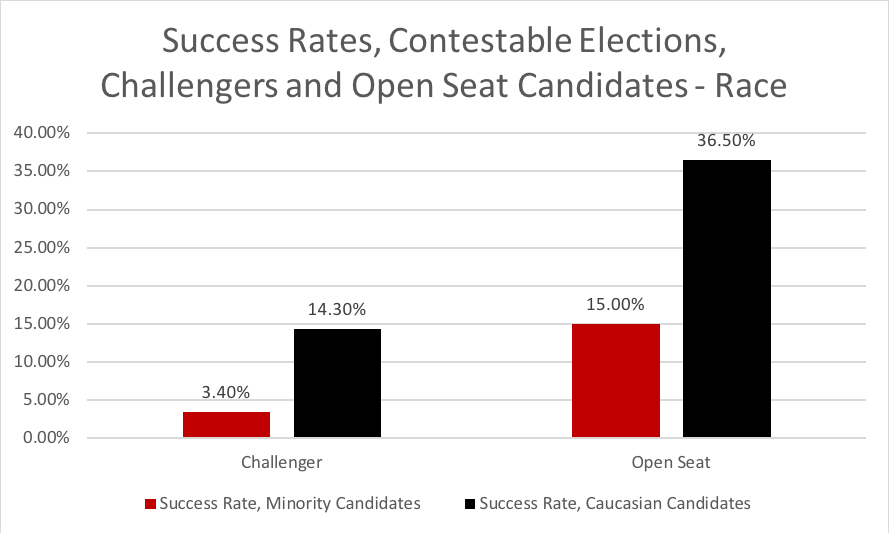
This disparity is even starker for women of color. Since our data began in 2000, a woman of color has never won a state supreme court election as a non-incumbent. During that period, only 20 out of 589 (or 3.4 percent) of total identifiable challengers or open seat candidates were women of color. Strikingly, all 20 lost their respective judicial races.
|
|
Minority Women |
|
|
|
Won |
Lost |
|
Challenger |
0.0% (0) |
100.0% (16) |
|
Open Seat |
0.0% (0) |
100.0% (4) |
When minority candidates reach the bench, through elections or interim appointments, they also lose more frequently than white incumbents.
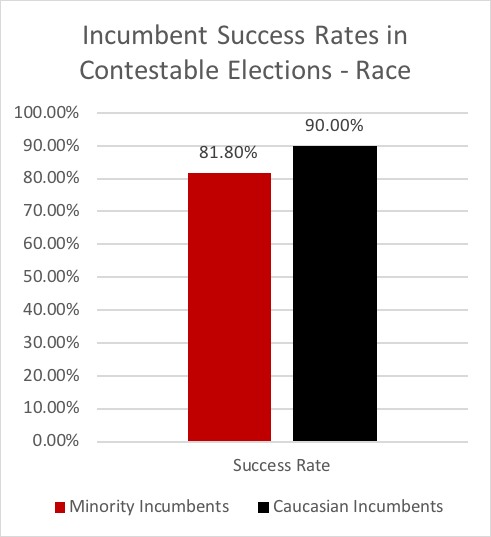
Notably, the incumbent advantage diverges across demographic groups. Minority men have by far the weakest incumbent advantage in contestable elections.
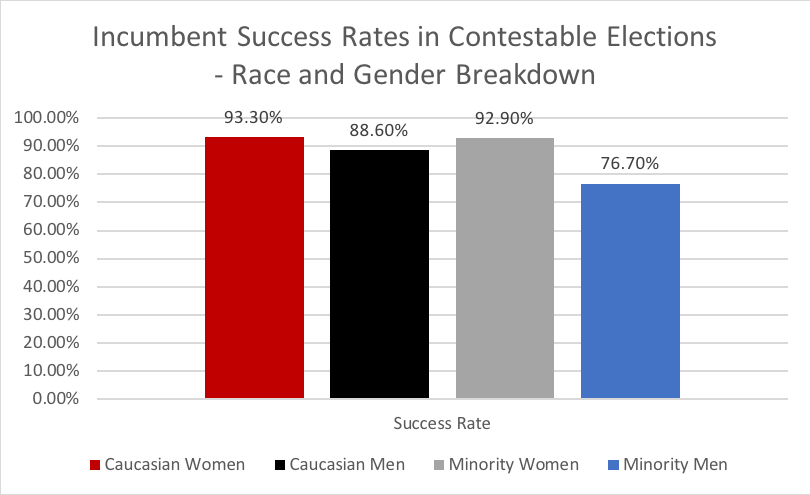
What should states do to address the lack of diversity on state supreme courts?
The striking lack of diversity in state supreme courts underscores the importance of dismantling hurdles to achieving and maintaining diverse state benches — and of building better pipelines to the bench. One key step for states with judicial elections is to adopt public financing, which evidence suggests can reduce barriers to entry to the political process for candidates of color. For states that use appointments, which the Brennan Center recommends for state supreme courts in lieu of elections, the Brennan Center has developed recommendations about how these systems can promote a diverse bench.
For resources on how to promote judicial diversity, see the Brennan Center resource page.
(Image: Shutterstock.com)
